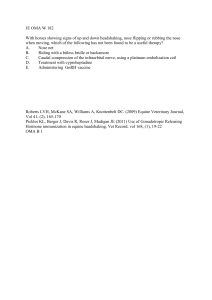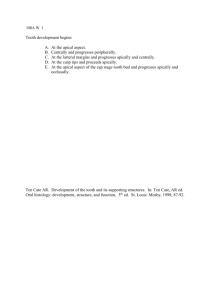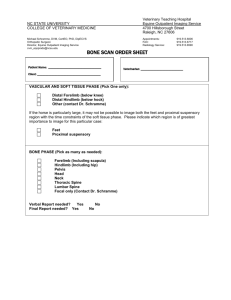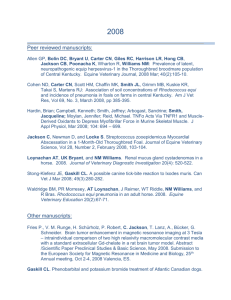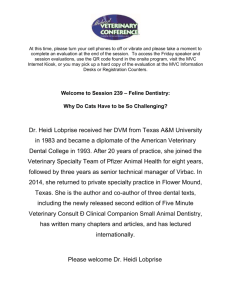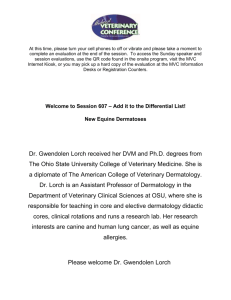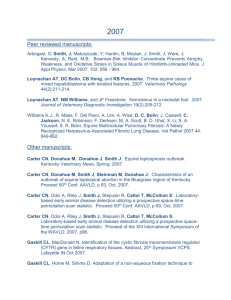Released EVDC Eq Exam Example Questions Operative Dentistry 12
advertisement
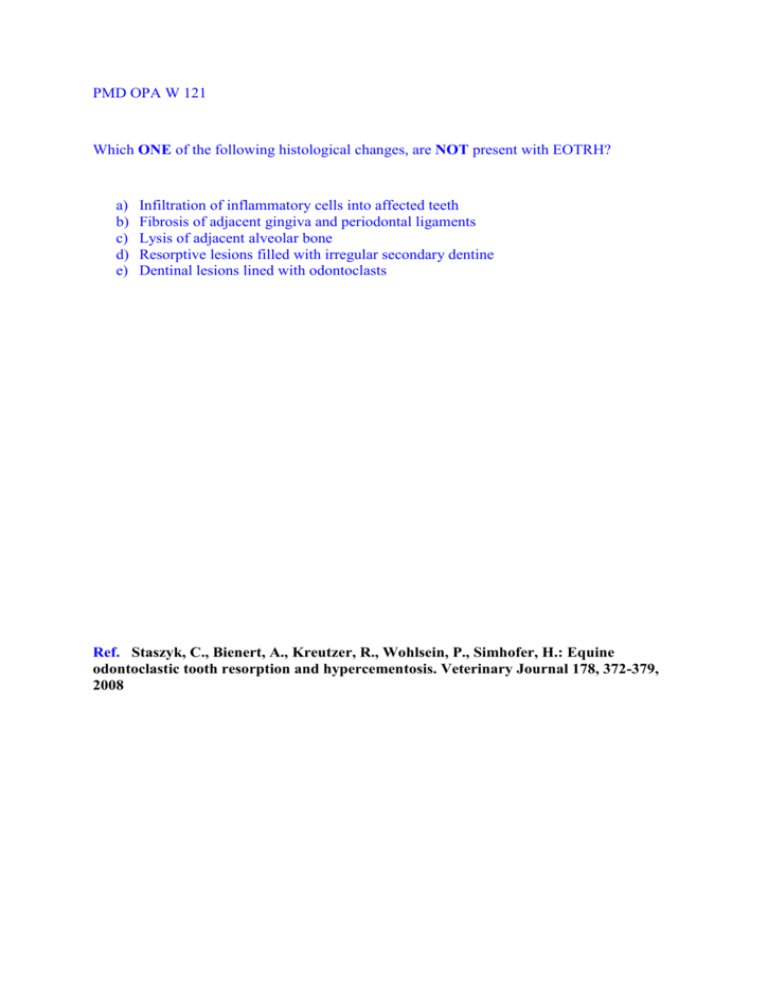
PMD OPA W 121 Which ONE of the following histological changes, are NOT present with EOTRH? a) b) c) d) e) Infiltration of inflammatory cells into affected teeth Fibrosis of adjacent gingiva and periodontal ligaments Lysis of adjacent alveolar bone Resorptive lesions filled with irregular secondary dentine Dentinal lesions lined with odontoclasts Ref. Staszyk, C., Bienert, A., Kreutzer, R., Wohlsein, P., Simhofer, H.: Equine odontoclastic tooth resorption and hypercementosis. Veterinary Journal 178, 372-379, 2008 OPA W 2 Mature enamel is capable of which ONE of the following? a) b) c) d) e) No repair Partial repair Temporary repair Almost complete repair Complete repair Ten Cate (1994 In: Oral Histology (4th ed.), ed. Ten Cate, A.R., The C.V. Mosby Company, St. Louis, pp 58-80, 111-119, 147-168. Dixon et al 2011 Dental Anatomy in: Equine Dentistry Eds Easley,j., Dixon,PM, Schumacher J 3rd edition Elsevier OPA B 1 Which of the following answers best describes the equine dental tissue demonstrated in the provided histological section? Ignore the black arrows. a) Equine Type 1 enamel b) Cementum c) Primary dentine d) Secondary dentine e) Equine Type 2 enamel Dacre IT, Kempson, S and Dixon PM (2008) Pathological Studies of Cheek Teeth Apical Infections in the Horse: Part 1 Normal endodontic anatomy and dentinal structure of cheek teeth The Veterinary Journal 178, 311-320 OPA B 2 Which of the following statements most accurately characterizes the image? a) b) c) d) e) This horse has suffered trauma to the rostral jaws. This horse has suffered from apical infections of its rostral teeth. This horse has a disseminated tumor of its rostral jaws. This horse has a very destructive form of EOTRH. This horse has a very proliferative form of EOTRH. Staszyk, C., Bienert, A., Kreutzer, R., Wohlsein, P., Simhofer, H.: Equine odontoclastic tooth resorption and hypercementosis. Veterinary Journal 178, 372-379, 2008. Dixon, PM, du Toit N and Dacre IT (2010) Equine Dental Pathology: Equine Dentistry (3rd Edition) Editors Easley, KJ, Dixon, PM and Scumacher JS Elsevier Saunders OPB W 1 In the modified G.V. Black lesion and cavity classification system, lesions on the buccal, labial or lingual aspect of an incisor are a. b. c. d. e. Class I Class II Class III Class IV Class V Wiggs RB, Loprise HB. Operative and Restorative Dentistry, in Veterinary Dentistry, Principles and Practice. Lippincott-Raven: Philadelphia (1997), 352 OPB B 92 In a study by Dacre I, Kempson S, Dixon PM “Equine idiopathic cheek teeth fractures. Part 1: Pathological studies on 35 fractured cheek teeth” (Equine vet J 2007; 39(4):310-318), the most common type of maxillary cheek tooth (CT) fracture involved both buccal pulp horns. Using the duToit numbering system for pulp horn identification, which fracture type(s) were the second most common in this publication? Select the best statement: A. Midline sagittal fractures through the infundibula of maxillary CT. B. Buccal slab fractures of mandibular CT through pulp horns 1 and 2 (duToit numbering system). C. Lingual slab fractures of mandibular CT through pulp horns 3 and 4. D. Buccal slab fractures of mandibular CT through pulp horns 1 and 2 and midline sagittal fractures through the infundibula of maxillary CT. E. Palatal fractures of maxillary CT through pulp chambers 3 and 4. Reference: Dacre I, Kempson S, Dixon PM. Equine idiopathic cheek teeth fractures. Part 1: Pathological studies on 35 fractured cheek teeth. Equine vet J 2007; 39(4):310-318. SSG OPC W 143 The treatment plan for the restoration of a cavity includes apply a glass ionomer as a base and a resin composite as the final restoration. Which of the following steps of cavity preparation is LEAST important for success of the restoration? A. The rough shape of the cavity is outlined using burs on a high-speed handpiece. B. All disease dentin is removed with hand instruments. C. The walls of the cavity are shaped with hand instruments to resist occlusal and shear forces. D. Dentinal undercuts are applied to ensure retention of the restorative materials. E. The margins of the restoration are planed with hand instruments to remove irregularities left by the bur. Ref: Galloway SS, Galloway MS. Dental Materials. In: Easley J, Dixon P, Schumacher J, eds. Equine Dentistry. 3rd edition. London: Saunders Elsevier; 2011. p. 335–358. (p. 336) Wiggs RB and Lobprise HB. Operative and Restorative Dentistry. In: Wiggs RB, Lobprise HB, eds. Veterinary dentistry: principles and practice. Lippincott-Raven, Philadelphia, 1997, p 351-394. (p. 365-6) Baum L, Phillips RW, Lund MR. Treatment of Carious Lesions. Baum L, Phillips RW, Lund MR, eds. Textbook of Operative Dentistry, 3rd Ed. WB Saunders, Philadelphia, 1995, p 158-186. (p.158-9) OPC B1 A cavity in tooth 403 has been grossly debrided and shaped with burs on a highspeed handpiece. Which instrument is most appropriate for finishing the margin the cavity preparation? a) b) c) d) e) A B C D E Ref: Wiggs RB and Lobprise HB. Dental Equipment. In: Wiggs RB, Lobprise HB, eds. Veterinary dentistry: principles and practice. Lippincott-Raven, Philadelphia, 1997, p 1-28. (p. 10-12).

